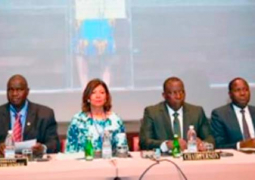
Last week this column looked at the new payments system infrastructure being promoted by the Central Bank of The Gambia, as a regional payments system initiative that forms an integral part of the prerequisites for effective West African monetary integration.
Payment systems are a set of instruments and means generally acceptable in making payments. It is precisely defined by the Committee on Payment and Settlement Systems of the Bank for International Settlements,
The modernised payments system being promoted in The Gambia by the CBG has other aspects that take into account Cheque Imaging System, Real Time Gross Settlement System (RTGS), Securities Settlement System (SSS), and National Switch (GAMSWITCH).
Here, following, is a vivid explanation of the aforementioned payments system criteria by the Central Bank, which also throws more light on frequently asked questions about the modernised payments system, especially on the aspect of its Cheque Imaging System.
How does the Cheque Imaging System operate?
The Automated Cheque Processing (ACP) operates by capturing cheque images through scanners, known as the Cheque Imaging System (CIS). The CIS offers the fastest and most secure mode for clearing cheques digitally. It replaces the physical exchange of cheques between the presenting and paying banks. However, cheques must be handled with care if the cheque scanners are to operate effectively. Henceforth, all cheques must bear the Magnetic Ink Character Recognition (MICR) code, Country code, bank code, branch code, etc. thus forms the basis for electronic processing. However, scanners cannot capture images of damaged cheques, which occur through any one or a combination of the following: writing on the MICR code area; folding of cheques in a form which may prevent its passage through the scanning machine; soiling of cheques with oils, paints or other permanent marks; wear and tear of cheques due to poor storage facilities; stapling of cheques; forgeries aimed at defrauding the system; and any other inappropriate means.
What is Real Time Gross Settlement System (RTGS)?
The RTGS is a system of transmitting payment instructions through direct means, known as direct debits or credits. It does not require the use of cheques but mere instructions for payment, which are acted upon by the counterparty, e.g. buying and selling of foreign currency between two banks. The RTGS also serves as the central system, where transactions converge from all the other systems (SSS, GAMSWITCH, ACP/ACH, etc), and interfaces with the CBG’s Core Banking Applications (CBA) to determine the overall balance of each participating bank. RTGS will handle large-value payments and ensure settlement instantaneously. Thus the problem of interbank credit risk is minimized through the operation of the payment system. All banks in The Gambia are direct members of the RTGS.
What does the Securities Settlement System (SSS) entail?
The SSS is suitably designed for the recording and management of all government securities, interbank transactions, repurchase obligations, intraday liquidity transactions and other government obligations. It aims to implement an automated “DELIVERY Vs PAYMENT” (DvP) process for securities settlement and to improve and regulate liquidity management in the Security Markets. The Real Time Gross Settlement (RTGS) System helps with the management of the cash leg of transactions. The RTGS and the SSS combine to ensure execution of payment and transfer of all securities traded or purchased simultaneously, guaranteeing delivery for all payments made, thus DvP.
What is National Switch (GAMSWITCH)?
GAMSWITCH is a nationwide switching system which facilitates communication between Automated Teller Machines (ATMS), thereby permitting customers of different banks use ATMs irrespective of their banks. It serves as the clearing house for electronic payments through debit and credit cards. It is expected to combine or eliminate the heavy dependence on cash based transactions.
What is the CIS in the context of clearing?
The Cheque Imaging System (or CIS) involves the physical movement of cheque images electronically, which will stop at some point in the clearing cycle, either at the level of the presenting bank or at the clearing house or even at the drawee bank.
In the context of CIS being implemented in The Gambia, the cheque image would be digitally processed at the level of the presenting bank. In other words, the cheque will not physically travel to the clearing house (at Central Bank of The Gambia) or to the drawee as it did hitherto. Nonetheless, the existing laws, namely the Banking Act 2009 and the Central Bank Act 2005 mandate the Central Bank of The Gambia to ensure a fully operational as well as safe and sound payments system. There is no single ideal way in which the legal framework should be organised. Central Bank has power to issue regulations to govern the operation of the systems which have statutory backing. This together with Participants Agreements will provide adequate legal foundation for the CIS. The new system is a legal process which merely replaces the physical exchange of cheques with electronic images but where challenged, the original cheque can always serve as further evidence of transaction.
How are the Images captured?
The electronic images and MICR data of cheques are captured using scanners. The MICR data complies with the MICR code as defined by the West African Monetary Zone (WAMZ) Cheque Standards. All cheques are required to be branded with bank’s special crossing stamp prior to scanning. The amount field needs to be keyed in. The scanner will print an endorsement at the back which is a unique identifier for the instrument [i.e. date of presentation, the clearing type, item sequence number, MICR code of the drawee bank, CBG issued Code of the presenting bank/branch, etc.
What happens to the physical Cheques?
It is mandatory for the presenting banks to store the physical instruments safely. In case needed, the physical cheques could be retrieved from the presenting bank through the drawee bank. The participating banks may surrender cheques to the drawee bank in accordance with an agreement, if one exists.
How is CIS being implemented in The Gambia?
The CBG is implementing CIS on a global basis, involving all the thirteen banks in the country. However, all Dalasi-denominated cheques in the country will have to be processed through the CIS. Cheques will be scanned at the presenting bank level and only the cheque images plus the associated data file would flow to the drawee banks/ branches through the CBG Clearing House. The settlement would be effected by the Clearing House based on the MICR date.
How is the uniqueness of cheques assured?
The images captured at the presenting bank level would be transformed to the drawee banks/branches via digital signatures of the presenting bank. The CBG has issued an area and bank/branch code to each of the participants, whilst customer cheques are personalised to prevent overlaps.
How is the quality of the images ensured?
As payment will be made based on the images, it is essential to ensure that good quality images are available for processing. For this purpose, the CBG has prescribed the image standards to member banks. The CIS solution also provides for Image Quality Audit (IQA) at different levels. Further, the drawee bank can call for the physical instruments if it is not satisfied with the image for payment processing.
What care and precautions are to be taken by the banks and their customers to ensure quality images?
All cheques need to be image friendly. The customers should preferably use dark coloured ink while drawing the instruments. Care should be exercised in the use of rubber stamps, so that it would not interfere with the material sections of the cheque. The date of the cheque, payee’s name, amount and signature are the basic features which are essential in a cheque. The use of rubber stamps, etc., should not overshadow the clear appearance of these basic features in the image. In order to ensure that all essential elements of a cheque are captured in an image during the scanning process, bank customers also need to exercise appropriate care when drawing cheques.
Will there be any change in the process for the customers?
There will be changes in the clearing process for customer. Although customers will continue to use cheques as at present, but the clearing cycles shortens from about four days to between 24 to 48 hours. Customers wishing to cancel cheques must do so before 1:30pm the following day after presentation (D+1), whilst rejection is done the same day the cheque is deposited or the following day before 1:30pm.
What would be the benefits of Cheque Imaging to customers of banks?
The benefits could be summarised as follows:
a) Faster and shorter clearing cycle. Shortens the current average clearing cycle of 3-6 business days in The Gambia to zero (i.e. payee receives value instantaneously)
b) Better reconciliation/verification process
c) Better customer service Elongated customer window during the business day.
d) Eliminates settlement risks. No uncertainty of dishonoured cheques as the phenomenon of bounced cheques will be eliminated and hence the associated cost and loss of income is avoided. Customer balances will be verified on Real Time Basis and transactions effected with immediacy. Immediate crediting of accounts means that any overdraft limit is reduced, hence lower interest charges. It also helps cash flow.
e) The scope of the clearing house can be extended nationwide, with no geographical dependence.
f) Operational efficiency will benefit the bottom lines of banks.
g) Minimises transactions costs
h) Reduces operational risk by securing the transmission route.
Are charges or fees applicable to the customers and participating banks?
CBG as the owner and operator of the system reserves the right to recover ongoing and variable cost where applicable by volume-based charges to the participant banks. The charges will be outlined in CBG policy documents relating to pricing and may be reviewed following due consultations with and taking into account the views of participating banks. However, CBG will be on a cost recovery basis, i.e. to cover the transaction (e.g. SWIFT) and system operation and maintenance costs and additional services rendered. The participating banks will similarly recover transaction cost from their customers for payment services rendered. Such fees shall be published for the information of the public.
What are the settlement schedules?
The National Payments Systems will operate on each business day of the week (excluding Saturdays, Sundays and public holidays). The settlement schedules decided by CBG are as follows: CIS {ACP/ACH} (Presentation - 8.00 am to 3.45 pm), RTGS (Operation - 8.00 am to 3.45 pm), and SSS (Operation - 8.00 am to 12.00 pm on Auction Day).
Cheques can be processed during business hours and beyond the cut-off time of the CIS. Settlement will only take place the following business day. The settlement schedules may be amended prior to the scheduled go live and may impact on the current banking hours. A major consideration in arriving at the final schedule is its feasibility and convenience of the public.
Are the systems secure and is availability assured?
CBG has established an architecture that will ensure continuity. The Primary site provides for a redundancy of systems servers that will make it possible to continue business in the event of some failure. A secondary site which is online allowing for replication of transactions on a real-time basis is also operational. This means that the systems can be operated from this alternative site if need be. The secondary site also acts as data backup. In addition, the communication network is dedicated to the system to ensure security.
There is dedicated functional and technical team at CBG for monitoring and overseeing the transactions and the systems during the day and provision of adequate liquidity during the day to allow conditions settlement is guaranteed. The Central Bank also provides Help Desk (service bureau) to facilitate the participation of a bank that may experience temporary failure at its workstation.
The solution providers have deployed similar systems in central banks across the globe. IT backup support and service agreements for all the systems are in place. The systems are secure, resilient, convenient, reliable and efficient.
Does CBG intend to issue directives?
CBG will issue directives aimed at facilitating the smooth operation of the CIS as and when considered necessary. For example, directives on the cessation of non-MICR cheques, manual clearing house, mandatory use of electronic funds transfer method for certain types of transactions and for amounts above thresholds as may be prescribed by CBG are necessary to achieve the efficiency envisaged.




